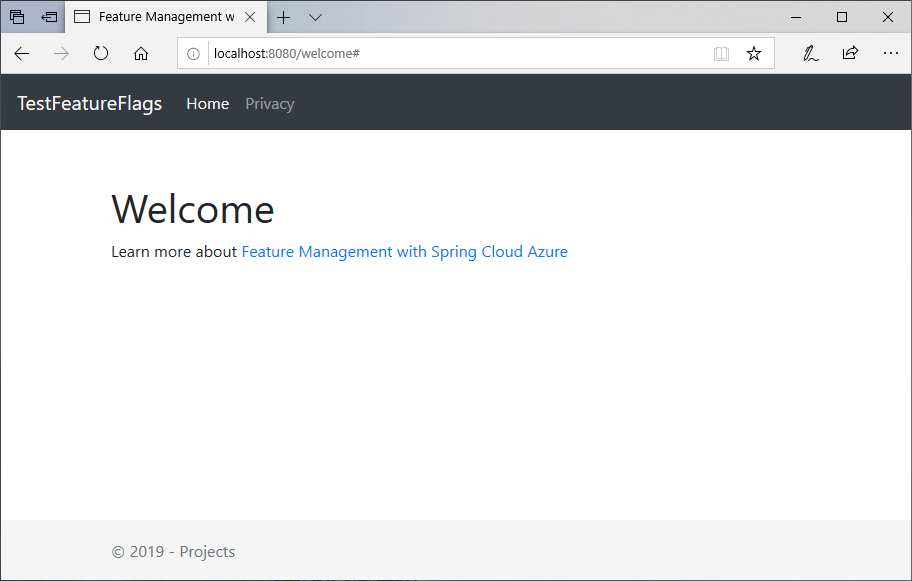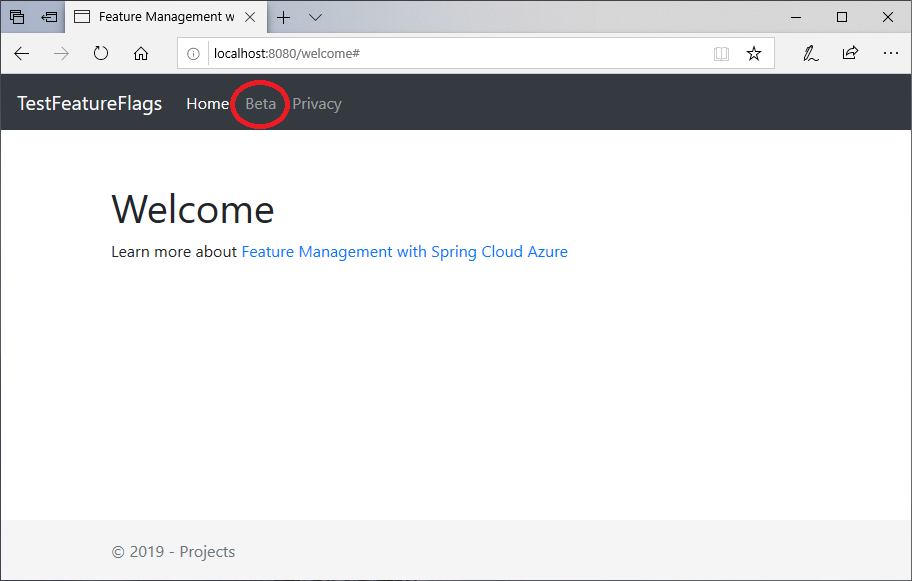opomba,
Dostop do te strani zahteva pooblastilo. Poskusite se vpisati alispremeniti imenike.
Dostop do te strani zahteva pooblastilo. Poskusite lahko spremeniti imenike.
In this quickstart, you incorporate Azure App Configuration into a Spring Boot web app to create an end-to-end implementation of feature management. You can use App Configuration to centrally store all your feature flags and control their states.
The Spring Boot Feature Management libraries extend the framework with comprehensive feature flag support. These libraries do not have a dependency on any Azure libraries. They seamlessly integrate with App Configuration through its Spring Boot configuration provider.
Prerequisites
- An Azure account with an active subscription. Create one for free.
- An App Configuration store, as shown in the tutorial for creating a store.
- A supported Java Development Kit SDK with version 11.
- Apache Maven version 3.0 or above.
Add a feature flag
Add a feature flag called Beta to the App Configuration store and leave Label and Description with their default values. For more information about how to add feature flags to a store using the Azure portal or the CLI, go to Create a feature flag.

Create a Spring Boot app
To create a new Spring Boot project:
Browse to the Spring Initializr.
Specify the following options:
- Generate a Maven project with Java.
- Specify a Spring Boot version that's equal to or greater than 2.0.
- Specify the Group and Artifact names for your application. This article uses
com.exampleanddemo. - Add the Spring Web dependency.
After you specify the previous options, select Generate Project. When prompted, download the project to your local computer.
Add feature management
After you extract the files on your local system, your Spring Boot application is ready for editing. Locate pom.xml in the root directory of your app.
Open the pom.xml file in a text editor and add the following to the list of
<dependencies>:
<dependency>
<groupId>com.azure.spring</groupId>
<artifactId>spring-cloud-azure-appconfiguration-config-web</artifactId>
</dependency>
<dependency>
<groupId>com.azure.spring</groupId>
<artifactId>spring-cloud-azure-feature-management-web</artifactId>
</dependency>
<dependency>
<groupId>org.springframework.boot</groupId>
<artifactId>spring-boot-starter-thymeleaf</artifactId>
</dependency>
<dependencyManagement>
<dependencies>
<dependency>
<groupId>com.azure.spring</groupId>
<artifactId>spring-cloud-azure-dependencies</artifactId>
<version>6.0.0</version>
<type>pom</type>
<scope>import</scope>
</dependency>
</dependencies>
</dependencyManagement>
Note
- There's a non-web Feature Management Library that doesn't have a dependency on spring-web. Refer to GitHub's documentation for differences.
Connect to an App Configuration store
Navigate to the
resourcesdirectory of your app and open thebootstrap.propertiesorbootstrap.yamlfile. If the file doesn't exist, create it.You can connect to your App Configuration store using Microsoft Entra ID (recommended), or a connection string.
Update your configuration files.
If you're using a properties file, use the following code:
spring.config.import=azureAppConfiguration spring.cloud.azure.appconfiguration.stores[0].endpoint= ${APP_CONFIGURATION_ENDPOINT} spring.cloud.azure.appconfiguration.stores[0].feature-flags.enabled=trueIf you're using a yaml file, use the following code:
spring: config: import: azureAppConfiguration cloud: azure: appconfiguration: stores: - feature-flags: enabled: true endpoint: ${APP_CONFIGURATION_ENDPOINT}You use the
DefaultAzureCredentialto authenticate to your App Configuration store. Follow the instructions to assign your credential the App Configuration Data Reader role. Be sure to allow sufficient time for the permission to propagate before running your application.Add the following code to your project, unless you want to use Managed Identity. Create a new file named
AppConfigCredential.java:import com.azure.data.appconfiguration.ConfigurationClientBuilder; import com.azure.identity.DefaultAzureCredentialBuilder; import com.azure.spring.cloud.appconfiguration.config.ConfigurationClientCustomizer; public class AppConfigCredential implements ConfigurationClientCustomizer { @Override public void customize(ConfigurationClientBuilder builder, String endpoint) { builder.credential(new DefaultAzureCredentialBuilder().build()); } }Create a new file named
MyConfiguration.javaand add the following lines:import org.springframework.context.annotation.Bean; import org.springframework.context.annotation.Configuration; @Configuration public class MyConfiguration { @Bean public AppConfigCredential clientSetup() { return new AppConfigCredential(); } }Add configuration Bootstrap Configuration, by creating
spring.factoriesfile underresources/META-INFdirectory and add the following lines and updatingcom.example.MyConfigurationwith your application package:org.springframework.cloud.bootstrap.BootstrapConfiguration=\ com.example.MyConfiguration
Create a new Java file named HelloController.java in the package directory of your app.
package com.example.demo; import org.springframework.beans.factory.annotation.Autowired; import org.springframework.stereotype.Controller; import org.springframework.ui.Model; import org.springframework.web.bind.annotation.GetMapping; import com.azure.spring.cloud.feature.management.FeatureManager; @Controller public class HelloController { @Autowired private FeatureManager featureManager; @GetMapping("/welcome") public String mainWithParam(Model model) { model.addAttribute("Beta", featureManager.isEnabled("Beta")); return "welcome"; } }Create a new HTML file named welcome.html in the templates directory of your app.
<!DOCTYPE html> <html lang="en" xmlns:th="http://www.thymeleaf.org"> <head> <meta charset="utf-8"> <meta name="viewport" content="width=device-width, initial-scale=1, shrink-to-fit=no"> <title>Feature Management with Spring Cloud Azure</title> <link rel="stylesheet" href="/css/main.css"> <link rel="stylesheet" href="https://stackpath.bootstrapcdn.com/bootstrap/4.3.1/css/bootstrap.min.css" integrity="sha384-ggOyR0iXCbMQv3Xipma34MD+dH/1fQ784/j6cY/iJTQUOhcWr7x9JvoRxT2MZw1T" crossorigin="anonymous"> <script src="https://code.jquery.com/jquery-3.6.0.min.js" integrity="sha256-/xUj+3OJU5yExlq6GSYGSHk7tPXikynS7ogEvDej/m4=" crossorigin="anonymous"></script> <script src="https://unpkg.com/@popperjs/core@2"></script> <script src="https://cdn.jsdelivr.net/npm/bootstrap@5.1.3/dist/js/bootstrap.bundle.min.js" integrity="sha384-ka7Sk0Gln4gmtz2MlQnikT1wXgYsOg+OMhuP+IlRH9sENBO0LRn5q+8nbTov4+1p" crossorigin="anonymous"></script> </head> <body> <header> <!-- Fixed navbar --> <nav class="navbar navbar-expand-md navbar-dark fixed-top bg-dark"> <a class="navbar-brand" href="#">TestFeatureFlags</a> <button class="navbar-toggler" aria-expanded="false" aria-controls="navbarCollapse" aria-label="Toggle navigation" type="button" data-target="#navbarCollapse" data-toggle="collapse"> <span class="navbar-toggler-icon"></span> </button> <div class="collapse navbar-collapse" id="navbarCollapse"> <ul class="navbar-nav mr-auto"> <li class="nav-item active"> <a class="nav-link" href="#">Home <span class="sr-only">(current)</span></a> </li> <li class="nav-item" th:if="${Beta}"> <a class="nav-link" href="#">Beta</a> </li> <li class="nav-item"> <a class="nav-link" href="#">Privacy</a> </li> </ul> </div> </nav> </header> <div class="container body-content"> <h1 class="mt-5">Welcome</h1> <p>Learn more about <a href="https://github.com/Azure/azure-sdk-for-java/tree/main/sdk/spring/spring-cloud-azure-feature-management/README.md">Feature Management with Spring Cloud Azure</a></p> </div> <footer class="footer"> <div class="container"> <span class="text-muted">© 2019 - Projects</span> </div> </footer> </body> </html>Create a new folder named CSS under
staticand inside of it a new CSS file named main.css.html { position: relative; min-height: 100%; } body { margin-bottom: 60px; } .footer { position: absolute; bottom: 0; width: 100%; height: 60px; line-height: 60px; background-color: #f5f5f5; } body > .container { padding: 60px 15px 0; } .footer > .container { padding-right: 15px; padding-left: 15px; } code { font-size: 80%; }
Build and run the app locally
Set an environment variable.
Set the environment variable named APP_CONFIGURATION_ENDPOINT to the endpoint of your App Configuration store found under the Overview of your store in the Azure portal.
If you use the Windows command prompt, run the following command and restart the command prompt to allow the change to take effect:
setx APP_CONFIGURATION_ENDPOINT "endpoint-of-your-app-configuration-store"If you use PowerShell, run the following command:
$Env:APP_CONFIGURATION_ENDPOINT = "<endpoint-of-your-app-configuration-store>"If you use macOS or Linux, run the following command:
export APP_CONFIGURATION_ENDPOINT='<endpoint-of-your-app-configuration-store>'Restart the command prompt to allow the change to take effect. Print the value of the environment variable to validate that it is set properly.
Build your Spring Boot application with Maven and run it.
mvn clean package mvn spring-boot:runOpen a browser window, and go to the URL:
http://localhost:8080/welcome.
In the App Configuration portal select Feature Manager, and change the state of the Beta key to On:
Key State Beta On Refresh the browser page to see the new configuration settings.

Clean up resources
If you don't want to continue using the resources created in this article, delete the resource group you created here to avoid charges.
Important
Deleting a resource group is irreversible. The resource group and all the resources in it are permanently deleted. Ensure that you don't accidentally delete the wrong resource group or resources. If you created the resources for this article inside a resource group that contains other resources you want to keep, delete each resource individually from its respective pane instead of deleting the resource group.
- Sign in to the Azure portal, and select Resource groups.
- In the Filter by name box, enter the name of your resource group.
- In the result list, select the resource group name to see an overview.
- Select Delete resource group.
- You're asked to confirm the deletion of the resource group. Enter the name of your resource group to confirm, and select Delete.
After a few moments, the resource group and all its resources are deleted.
Next steps
In this quickstart, you created a new App Configuration store and used it to manage features in a Spring Boot web app via the Feature Management libraries.
- Library reference documentation
- Learn more about feature management.
- Manage feature flags.
- Use feature flags in a Spring Boot Core app.